Most people traveling down the historic Route 66 through Nevada and Arizona are looking for sights such as old diners and bars, historical structures, and the locations where stories of legendary characters of the past took place. They likely drive right by Keepers of the Wild Animal Rescue Sanctuary, between Kingman and Valentine, Arizona, without much of a second glance. A very low-key entrance with one billboard out front and a small building for a ticket center/gift shop is all that is visible in front of the tall, screened chain-link fence. The average traveler may not be curious enough at the sight of the lone billboard to stop and check it out.
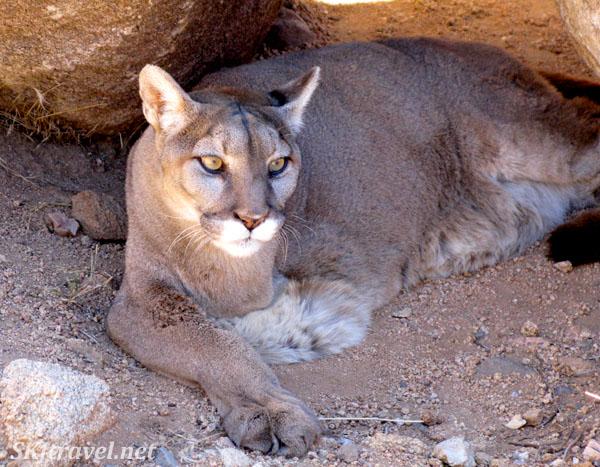
Mountain lion, Baby. Her left front leg was amputated due to injury.
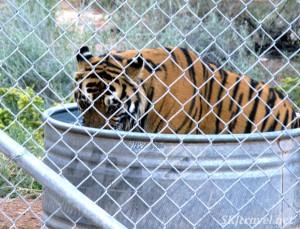
Tiger eating dinner inside her water tank, she likes to clean her meat
Keepers of the Wild is a rescue sanctuary primarily for animals – mostly large cats – who have been retired from the entertainment industry, or surrendered or confiscated as private exotic pets. Though the sanctuary will take in any animal from any situation, their primary citizens are former entertainment tigers. The founder, Jonathan Kraft, was once such an entertainer. He bought some tiger cubs, raised, trained and performed them. Eventually he “saw the light” that these wild and majestic animals shouldn’t live their lives in tiny cages and be demoralized by circus acts, their daily routine dictated by a human’s whip.
Working up through larger and larger tracts of land, and now planning a much larger state-of-the-art facility closer to Las Vegas, Kraft first released his own tigers and then began taking in other animals. In the current facility, the big cats have large open-air enclosures with varied terrain, rocks and bushes, logs and water barrels. One of the tigers always climbs inside her water barrel to eat her meat.
I spent 10 days there this past October with my friend, Doreen Ingram, who has written a children’s book about the animals in the sanctuary. I was told the stories of many of the unfortunate creatures … tigers kept in horrifically small cages with cement floors so their skin was full of sores, their muscles so atrophied they could hardly walk across their new open-air enclosures at Keepers; “exotic pets” such monkeys who had had their teeth pulled by their owners so they wouldn’t bite, monkeys taught to perform rude and explicit behavior for the entertainment of their depraved owners; goats discovered lost and bobcats found injured; difficult animals surrendered by zoos who couldn’t deal with them, such as little “Precious,” the ring-tailed lemur.
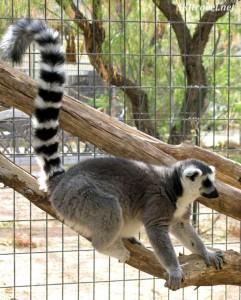
Precious is a precocious ring-tailed lemur.
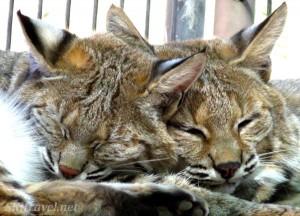
Rescued bobcats snuggling together for an afternoon nap.
Keepers of the Wild is a nonprofit organization; your entrance fee helps maintain the facility and support the $60,000+ per month food bill to feed the animals. Most of this is footed by private donations. Visitors can walk around the grounds along the dirt paths by themselves or take a guided tour in a vehicle. The best time to visit is in the afternoon about 3:00 for feeding time, when you can witness the awesome sound of raw carnivore emotion: “I’m hungry and I smell meat!” and very importantly, “This is mine; keep away!” The guides will give you background information on where the individual animals were rescued from, as well.

Sebastian, with his piercing blue eyes, is very possessive of his dinner.
A very rewarding experience is to spend several days volunteering. Chores are mostly chopping up fruits and vegetables, lots of laundry, as the smaller animals such as the monkeys get soft blankets to sleep with each night, and washing all the feeding dishes. While these aren’t the most exciting jobs in the world, the payoff is getting to spend time with the animals up close as you feed them their meals, and you will have access to areas inaccessible to daytime visitors. The primary focus of the sanctuary is providing a good home to the rescued animals, not providing the public with a prime viewing experience (contrary to a zoo), so there are sometimes animals residing off the visitor pathways, recently rescued and awaiting an enclosure to be built for them. As so much of the sanctuary’s budget goes toward food and enclosure construction and maintenance, volunteer work is extremely valuable, even a necessity, for the operations.
If you decide to stay and volunteer, a wide variety of lodging is available in Kingman. Kingman isn’t exactly a culinary heaven, but there is one delicious sushi restaurant, and a nice pizza-and-beer joint on the highway halfway between Kingman and the sanctuary.
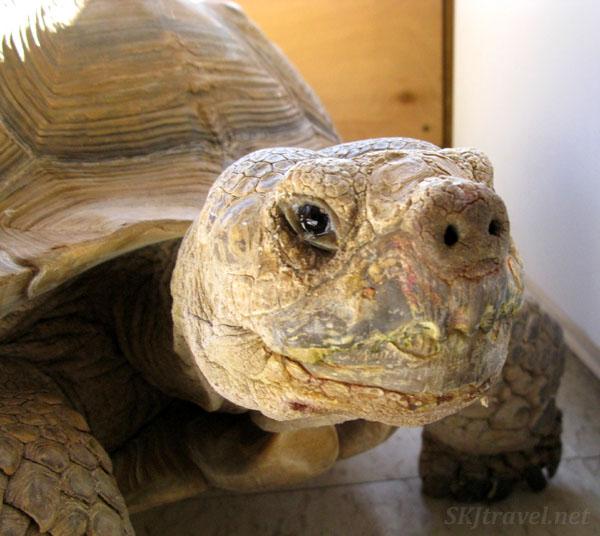
Bob the tortoise weighs in at about 70 pounds. He was recovering from illness and only volunteers could see him.

